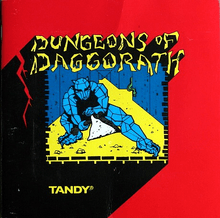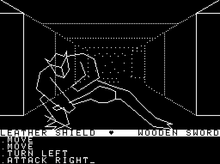Dungeons of Daggorath
| Dungeons of Daggorath | |
|---|---|
 Cover artwork. | |
| Developer(s) | DynaMicro[1] |
| Publisher(s) | Tandy Corporation |
| Designer(s) | Douglas J. Morgan[2] |
| Engine | Custom |
| Platform(s) | TRS-80 Color Computer, Dragon computer |
| Release date(s) | 1982 |
| Genre(s) | Dungeon crawl |
| Mode(s) | Single player |
| Distribution | ROMpak cartridge |
Dungeons of Daggorath is one of the first real-time, first-person perspective role-playing video games. It was produced by DynaMicro for the Tandy (RadioShack) TRS-80 Color Computer in 1982.
The game was written by Douglas J. Morgan and Keith S. Kiyohara, with sounds by Phil Landmeier, in 1980-81. It was released as an eight kilobyte ROMpak cartridge for the Color Computer, which took several months of recoding to achieve. Despite this, the game features a multi-level maze and has what for the time were advanced sound effects that provide important clues to the locations of monsters.[3]
Despite what are now outdated graphics and sound, the game still enjoys a cult following in the retrogaming community for its challenging and engaging gameplay, and has been ported to Microsoft Windows XP and Linux via the SDL graphic and sound libraries.
Gameplay
Dungeons of Daggorath was one of the first games that attempted to portray three-dimensional space in a real-time environment, using angled lines to give the illusion of depth. It followed the 1974 games Maze War and Spasim, written for research computers, and the first 3D maze game for home computers, 3D Monster Maze, released in 1981. The game Phantom Slayer, which like Daggorath was released in 1982 for the Color Computer, also featured monsters lurking in a maze. While Daggorath was visually similar to these games, it added several elements of strategy, such as different kinds of monsters, complex mazes, different levels of visibility, and the use of different objects and weapons.[4]

The player moves around a dungeon, issuing commands by means of typing — for example, typing "GET LEFT SHIELD" or "USE RIGHT TORCH" (or abbreviations such as "G L SH" and "U R T"), gathering strength and ever more powerful weapons as the game progresses. Various creatures appear, and can often be heard when they are nearby, even when not visible. The object of the game is to defeat the second of two wizards, who is on the fifth and last level of the dungeon.
A unique feature of the game is a heartbeat which rises as the player moves and takes actions within the virtual environment. The heartbeat is a direct predecessor of the "health" indicator in later games; the higher the heart rate, the more vulnerable the player is to attack. The player can faint from overexertion, in which case there is the risk of being attacked while defenseless. This heartbeat system was used instead of numerical statistics such as hit points or vitality, and was inspired by arcade games,[5] specifically 1978's Space Invaders where a heartbeat-like sound gradually increases pace as enemies advance towards the player.[6]
Sequel
After Dungeons of Daggorath became one of the most popular Color Computer games, Tandy produced a sequel, Castle of Tharoggad,[7][8] which was made without the participation of the Daggorath team. It did not sell well, and received poor reviews from fans of the original.[9]
In popular culture
Dungeons of Daggorath featured in the book Ready Player One, where the protagonist has to solve the game, emulated within a simulated universe.
See also
- Battlezone (1980 video game)
- Akalabeth: World of Doom
- Advanced Dungeons & Dragons: Treasure of Tarmin
References
- ↑ Hirsch Electronics Expands Board of Directors, June 2007, News Release, AutomatedBuildings.com
- ↑ Grant of license to reproduce Dungeons of Daggorath
- ↑ A Review of DynaMicro's The Dungeons of Daggorath (1982), 13 October 2006, By Matt Barton, Armchair Arcade
- ↑ Dungeons of Daggorath, Tandy (TRS-80) Color Computer Games, A set of Coco 1/2/3 web pages by L. Curtis Boyle, NitrOS9.LCURTISBOYLE.COM
- ↑ Barton, Matt (2008). Dungeons & Desktops: The History of Computer Role-Playing Games. A K Peters, Ltd. pp. 80–1. ISBN 1-56881-411-9. Retrieved 2010-09-08.
- ↑ Bill Loguidice & Matt Barton (2009), Vintage games: an insider look at the history of Grand Theft Auto, Super Mario, and the most influential games of all time, Focal Press, p. 232, ISBN 0-240-81146-1, retrieved 2011-05-01
- ↑ Castle of Tharoggad, Tandy (TRS-80) Color Computer Games, A set of Coco 1/2/3 web pages by L. Curtis Boyle, NitrOS9.LCURTISBOYLE.COM
- ↑ Castle of Tharoggad, Color Computer Documentation Website
- ↑ Castle of Tharoggad, Retrogaming Times Monthly 69, Feb 2010